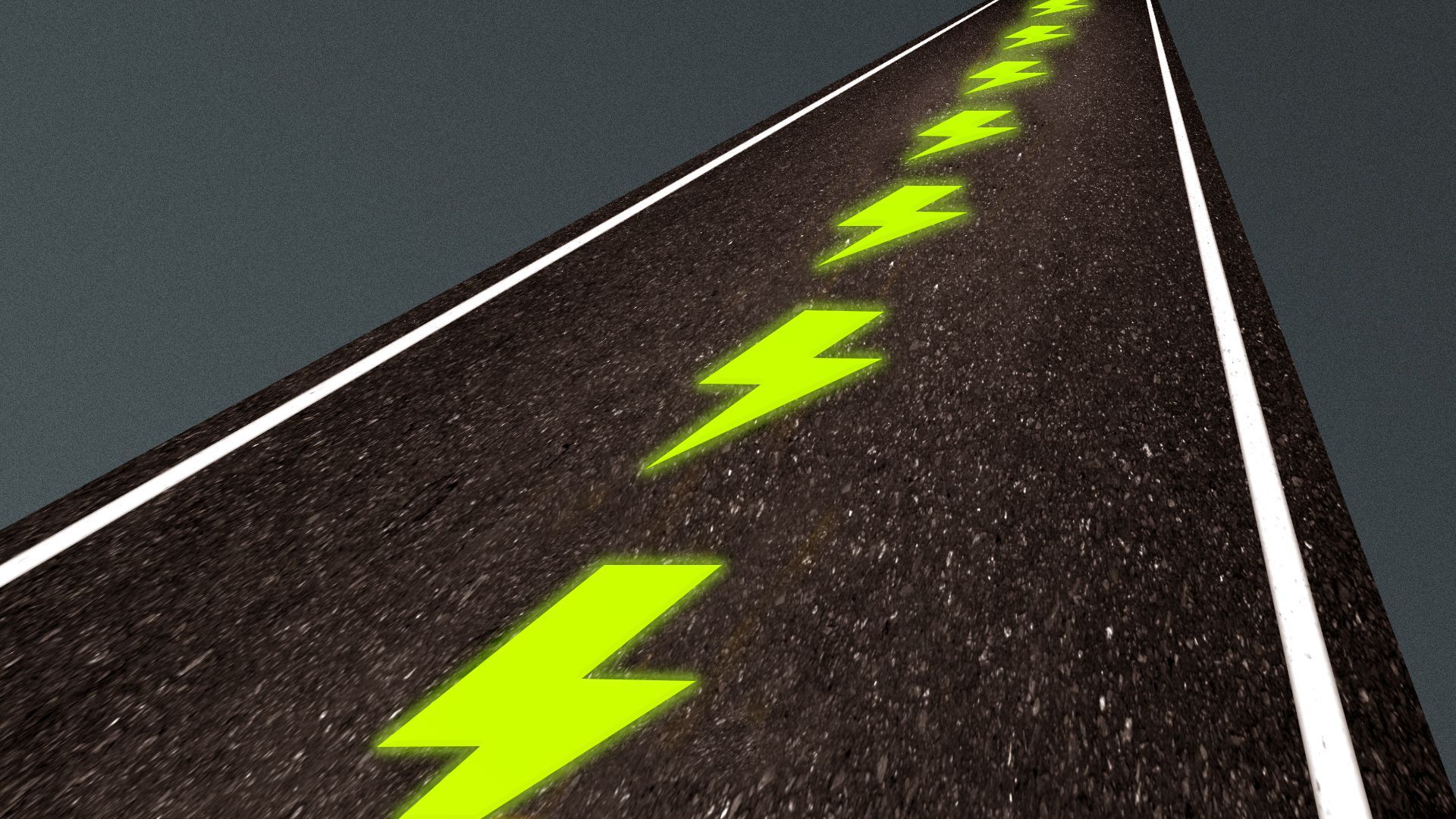| | | | | | | Presented By Ericsson | | | | Axios Generate | | By Ben Geman and Andrew Freedman · Apr 07, 2022 | | ☕ Good morning everyone and happy Thursday. Today's Smart Brevity count is 1,284 words, 5 minutes. | | | | | | 1 big thing: April to be first month in human history at 420 ppm |  Data: NOAA and Scripps Institution of Oceanography; Chart: Thomas Oide/Axios Monthly average carbon dioxide (CO2) levels are very likely to hit or even exceed 420 parts per million during the month of April, according to readings at the Mauna Loa Observatory in Hawaii, Andrew writes. Why it matters: This is a new record high for human history, and very likely the highest level seen in 4.1 million to 4.5 million years. - Scientists tell Axios that the sustained year-to-year growth rates in CO2 concentrations are unprecedented.
Driving the news: The amount of CO2 in the air continues to increase as people burn fossil fuels and chop down rainforests for agriculture, among other activities. Observations made in the relatively pristine air atop Mauna Loa have taken place since 1958, starting out at 316 ppm. Context: The data plotting the increase in CO2 is known as the Keeling Curve, named after Charles Keeling, who started and maintained the observations. - Charles Keeling's son Ralph continues his father's legacy by extending the data.
- Ralph Keeling told Axios the first few days of April have shown CO2 levels at or above 420 ppm, and based on month-to-month growth rates, this will be the first month to eclipse this milestone.
- "I think it's virtually a done deal," he said of the monthly average, noting it will increase further in May.
What they're saying: "CO2 is still rocketing up. If you look at the record, it's just relentless. So as much as people have been working hard and need to be working hard to slow the growth rate, we have to be honest that we haven't done much yet to actually curb the build-up," Keeling said. - Pieter Tans, who tracks greenhouse gases for the National Oceanic and Atmospheric Administration, said the speed of the CO2 increase is striking. Tans said CO2 will be "over 420 ppm" during April.
- Coming out of the last ice age, he said, CO2 went up by about 80 ppm during 6,000 years. Yet now it's increasing by more than 2 ppm "every single year."
- The 400 ppm milestone was eclipsed less than a decade ago, in 2013, and 440 ppm isn't far off, he warned. He described the growth rate as "an explosion" from a geological perspective.
The intrigue: The CO2 concentration numbers may seem abstract, but they correspond to huge upticks in the amount of heat being added to the oceans and atmosphere. This is melting ice caps and raising sea levels, as well as leading to increasingly destructive extreme weather events. What's next: The typical annual peak in CO2 amounts at Mauna Loa occurs in May, before vegetation in the Northern Hemisphere soaks up the gas throughout the warm season. |     | | | | | | 2. Meet the new $100M climate tech fund |  | | | Illustration: Aïda Amer/Axios | | | | There's a new climate VC player in town: Voyager Ventures, which yesterday announced itself and its first fund of $100 million aimed at early-stage companies in North America and Europe, Ben writes. Driving the news: There's a heavy dose of Silicon Valley and corporate leadership in its LP base, Megan Hernbroth reports in the Axios Pro Climate Deals newsletter (sign up here). - General partners at NEA, Insight Venture Partners and USV have all contributed to the fund.
- Lyft CEO Logan Green, Shopify founders Fiona McKean and Tobi Lütke are investors and Lowercarbon Capital's Chris Sacca is also an LP.
Zoom in: The two founders bring a deep mix of corporate, tech and policy experience. - Sierra Peterson is an early-stage tech investing vet, and also served in the Obama White House and the International Energy Agency.
- Sarah Sclarsic's background includes co-founding car-sharing firm Getaround and serving as the founding business director of Modern Meadow, "the world's first company making biofabricated leather and meat," Voyager's website notes.
|     | | | | | | 3. Catch up fast on Russia and Europe | | Russia: "Shell has announced that it will write off between $4 and $5 billion in the value of its assets after pulling out of Russia following the country's unprecedented invasion of Ukraine." (CNBC) Decarbonization: "Boris Johnson has announced plans to increase Britain's offshore wind power capacity fivefold by the end of the decade as part of a push to make 95 per cent of the country's electricity 'low carbon' by 2030." (Financial Times) - The plan also calls for significantly more nuclear power.
Europe: "Germany's economy and climate ministry presented a package of measures on Wednesday to speed up the expansion of renewable energy, as the need to reduce the country's heavy reliance on Russian fossil fuels adds urgency to its green transition plans." (Reuters) |     | | | | | | A message from Ericsson | | How 5G and modern tech can help achieve global climate goals | | |  | | | | Ericsson introduces an innovative approach for securing network energy efficiency, including four key elements: - Prepare the network.
- Activate energy-saving software.
- Build 5G with precision.
- Operate site infrastructure intelligently.
| | | | | | 4. Gasoline sales and miles traveled: a fraying link |  | | | Illustration: Gabriella Turrisi/Axios | | | | A brief new federal report suggests growth of electric vehicles, while still a very small share of the fleet, is starting to meaningfully alter gasoline consumption, Ben writes. Driving the news: The Energy Information Administration notes that in some states, the 2021 return of gasoline sales from the pandemic is lagging the rebound in vehicle miles traveled (VMT). - It compared 2021 to 2015-2019 averages.
- "These states' gasoline sales may be affected by increased penetration of electric vehicles, more residents working from home, or other effects."
Zoom in: The effect is noteworthy in California, by far the largest electric vehicle market. "California, which exhibited large disparities between VMT and gasoline sales, also has a relatively higher penetration of HEV, PHEV, and BEV," EIA notes, referring to hybrids, plug-in hybrids and fully electric cars. Yes, but: It urges caution when exploring national trends and cites multiple variables, ranging from vehicle efficiency to lifestyle changes. |     | | | | | | 5. Takeaways from Big Oil's day in the hot seat |  | | | Illustration: Rebecca Zisser/Axios | | | | House Democrats' grilling of oil execs over gas prices was basically a six-hour version of our preview in yesterday's edition, but also provided some interesting moments, Ben writes. A few things caught my eye at yesterday's House Energy and Commerce Committee hearing... Republicans' target wasn't in the room. GOP lawmakers attacked White House energy policies they call hostile to domestic producers. - But while industry officials agreed with some criticisms, other forces are acting as a brake on the pace of production growth.
- Pioneer Natural Resources CEO Scott Sheffield cited "severe" constraints on rigs and other equipment, as well as labor supply woes.
Time is a flat circle. Oil execs emphasized their business is cyclical as Democrats, facing political jeopardy over gas prices, hit them on large 2021 profits. - One exchange captured it: Committee chairman Frank Pallone (D-N.J.) asked all the execs to list their profits in 2021, a lucrative year.
- Execs with BP, Chevron, Exxon and Pioneer Natural Resources shoehorned in mention of their huge losses in 2020.
Capitalism is going to capitalism. Democrats hammered the companies over stock buybacks and dividends. Companies refused to say they would reduce them, but also argued they're not inconsistent with boosting output. CNN has more on that exchange. The timing was remarkable. It unfolded amid a commodity shock from Russia's war and 48 hours after the United Nation's sobering report on the need to quickly move away from fossil fuels to check global warming. It's a tough fit. Some Democrats pressured the companies to boost production while several members also called for stronger steps on climate. Go deeper: The NYT has a good rundown. |     | | | | | | 6. Google leads electricity deal |  | | | Illustration: Brendan Lynch/Axios | | | | A trio of marquee clean-energy players is enabling PJM Interconnection, the nation's largest competitive wholesale electricity market, to reduce load by expanding demand-response to residential customers' thermostats, Axios' Alan Neuhauser reports. Why it matters: Demand-response programs can help utilities and others avoid costly upgrades by enabling them to rein in demand at peak times, and help utilities and grid operators make better use of smart devices. How it works: Google Nest, Voltus and Resideo are introducing this capability through a "bring your own thermostat" program. - The program is being rolled out to select customers served by PPL Electric Utilities in Pennsylvania.
- The effort will allow PJM Interconnection to dial back customers' HVAC systems when load is peaking, effectively allowing the grid operator to control one of the most energy-hungry consumer systems.
Read more. |     | | | | | | A message from Ericsson | | Breaking the energy curve: How to reduce mobile network energy use | | |  | | | | The ICT sector must leverage ultra-lean design features of 5G to break the increasing energy consumption curve of mobile networks. Here's why: 5G is the most energy-aware standard with network energy performance fully integrated into its design. Get the details. | | | | Thanks so much for reading and see you here tomorrow. |  | It's called Smart Brevity®. Over 200 orgs use it — in a tool called Axios HQ — to drive productivity with clearer workplace communications. | | | | | | Axios thanks our partners for supporting our newsletters. If you're interested in advertising, learn more here.
Sponsorship has no influence on editorial content. Axios, 3100 Clarendon Blvd, Suite 1300, Arlington VA 22201 | | | You received this email because you signed up for newsletters from Axios.
Change your preferences or unsubscribe here. | | | Was this email forwarded to you?
Sign up now to get Axios in your inbox. | | | | Follow Axios on social media:    | | | | | |










No comments:
Post a Comment